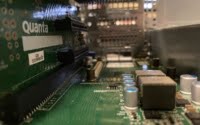Used Server Parts – Q3/2022 Quarterly Pricing Graphs
You may be familiar with our monthly pricing report for used server parts. In order to make the pricing trends more concise, we are starting a new feature where we show the previous 12 months pricing data in graphical format. This is the second quarterly installment of this new report.
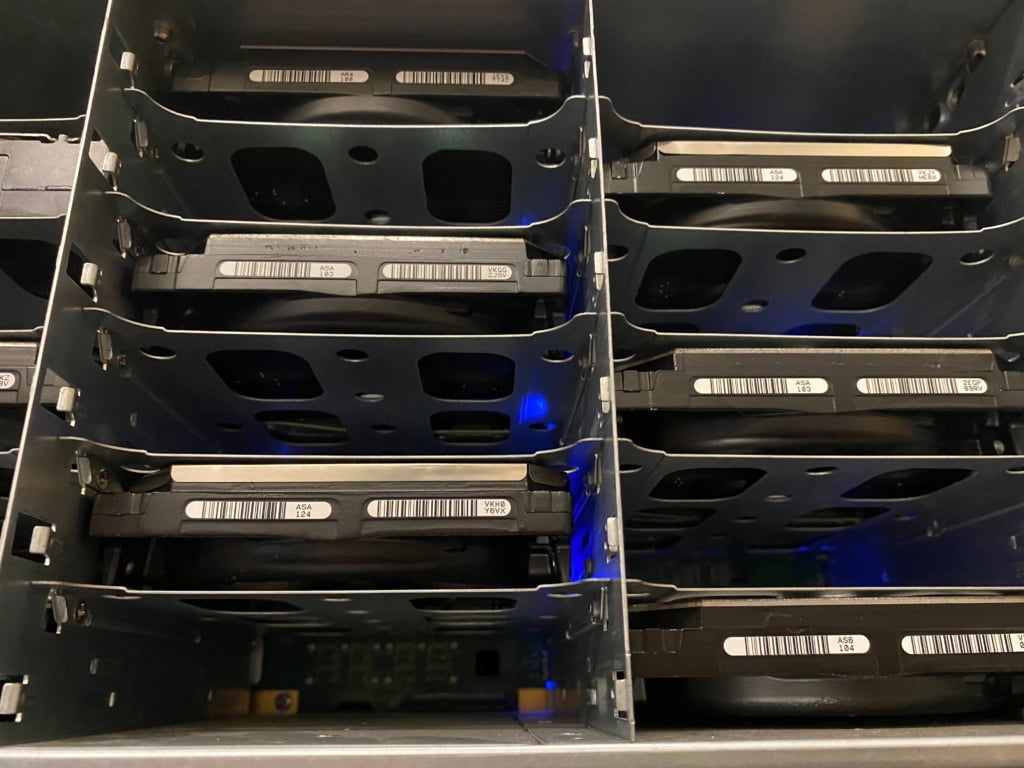
In our monthly price blogs we track various models of server parts. Please see our most recent post here.
In order to present the data in a legible manner we have separated these prices into the following categories:
- SAS and NVME SSD
- SATA SSD
- Hard Disk Drives
- DDR3 RAM
- DDR4 RAM
- Mid-Tier CPU
- High End CPU
_______________________________________________
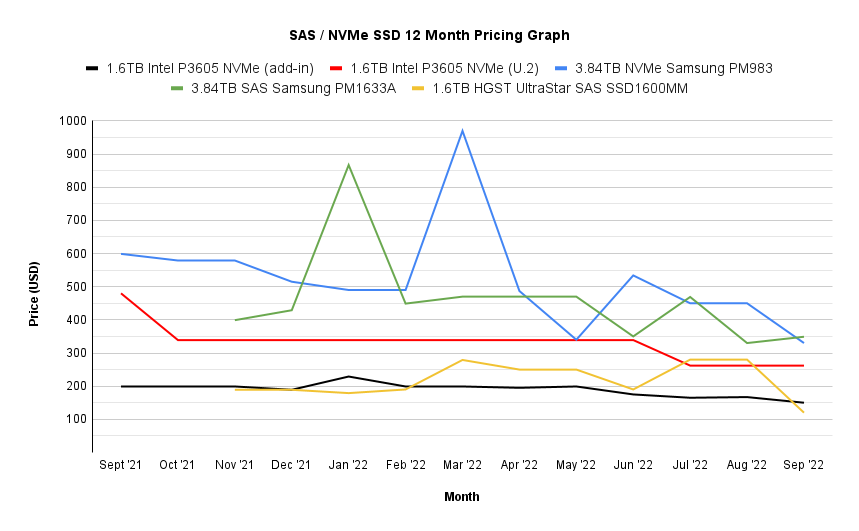
Currently we are tracking a handful of Non-SATA SSDs, and we are paying attention to only two sizes, 1.6TB and 3.84TB. Among the erratic data, the U.2 model of the 1.6TB P3605 has remained consistent. The reality is that since we started tracking this drive it has not always been available for purchase. Finding this card on the aftermarket requires clever keyword searching, and digging through listings to find the proper model number contained within the listing’s cover photo. As such, we are not always able to find an accurate price of the month for that drive type. Despite this, the times that we are able to track down a valid listing, we have observed that he price is lower than what we last found it listed at. In fact, all of the tracked Sas/NVMe SSDs are at a lower price point than the last Quarterly Report (May ’22).
_______________________________________________
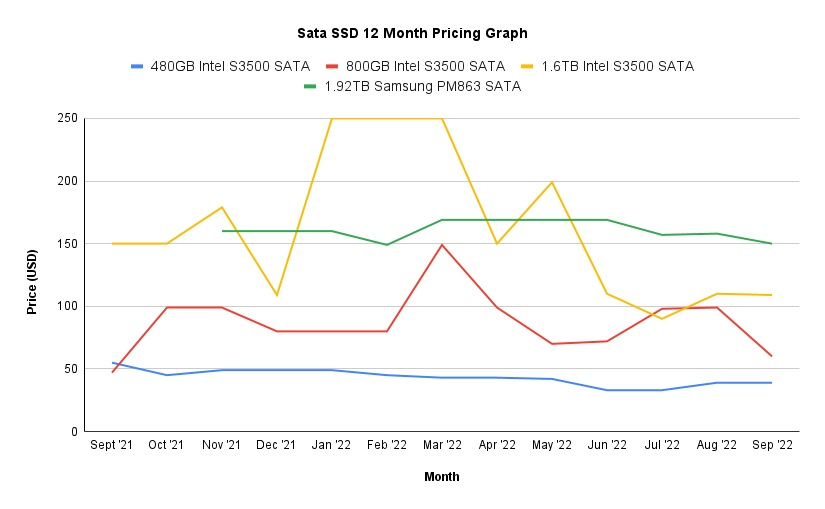
While the graphs for the Sata SSDs are just as erratic as the SAS/NVMe types, the price points are at a much lower scale. At this time, the largest SATA SSD (1.92TB Samsung) can be found around the same price as the smallest SAS/NVMe drives (1.6TB Ultrastar/1.6TB P3605 add-in). As the Sata SSDs are more prevalent in existing systems, it is not irregular to see a drastic price drop when a provider decides to upgrade systems to larger/faster SSDs as they become available. Due to this, if you are not in a rush to order these SSDs, it can pay to check the market regularly and buy when someone is emptying their stock for a cheaper than average price.
_______________________________________________
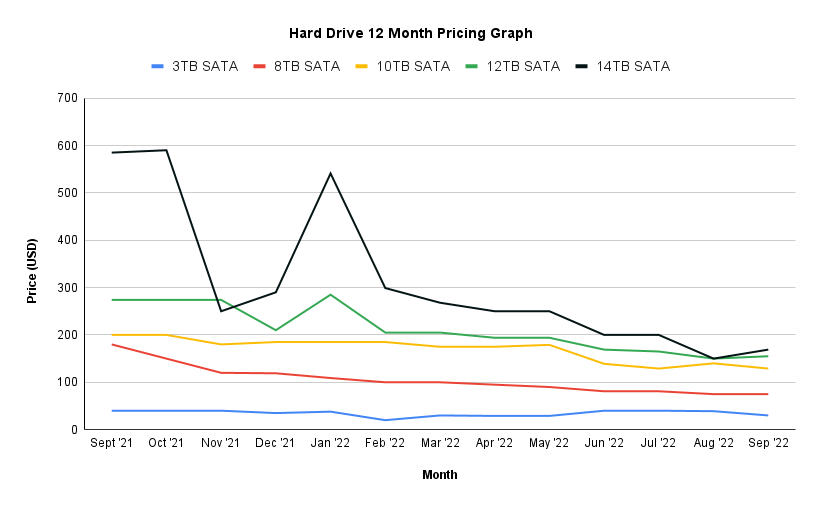
The change over time is easy to visualize with this graph. Around this time last year the prices for most Hard Disk drives were almost double the price they are now. This is most prevalent in all sizes except the 3TB HDDs, which have remained consistent for the past year. Just as we observed in our last quarterly report, the 8TB HDD have been a sweet spot for price vs capacity, pricing a bit under $10 per TB. The larger HDD sizes have improved in price vs capacity but are still hovering around $12 per TB.
The 12TB and 14TB sizes have had a slight increase in the past month, while the 10TB has had a slight drop. Only time will tell if the large HDD sizes will continue to fall in price, but until there are better solutions for storage based servers needing large amounts of space, we can predict the demand will keep the price high.
_______________________________________________
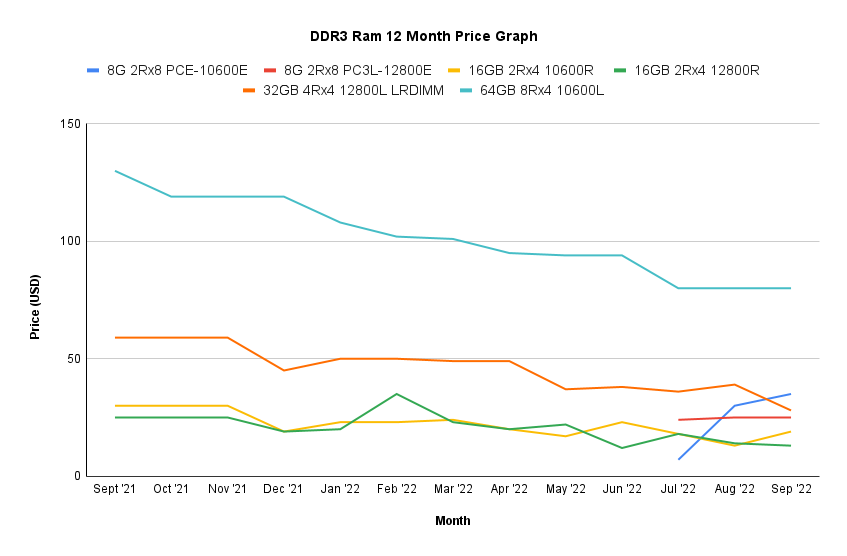
Over the past year, the price for DDR3 Memory has been on a slight downward trend. At this time, At this point in time, the 16GB and 32GB types are at a lower price point than they were during the last Quarterly Report (May ’22). Since then we have started to track two new types of RAM, 8GB 2rx8 PC3L-10600E and 8GB 2Rx8 PC3L-12800E ECC REG. These types of ram are commonly used with Intel E3 V1/2/3 CPUs. In the few months we have been tracking these two, we have noticed a volatility in the pricing for 12800E speeds, likely due to the very low availability of these on the aftermarket. It remains to be seen whether the prices for 16GB and 32GB dimms will continue to fall. We have observed the stock of those sizes are always in good supply, and as a result there should be no shortage that causes the price hikes we observed with the 8GB 12800E. And as the prices for higher tier hardware also fall, the demand for the older generation memory may fall even further.
_______________________________________________
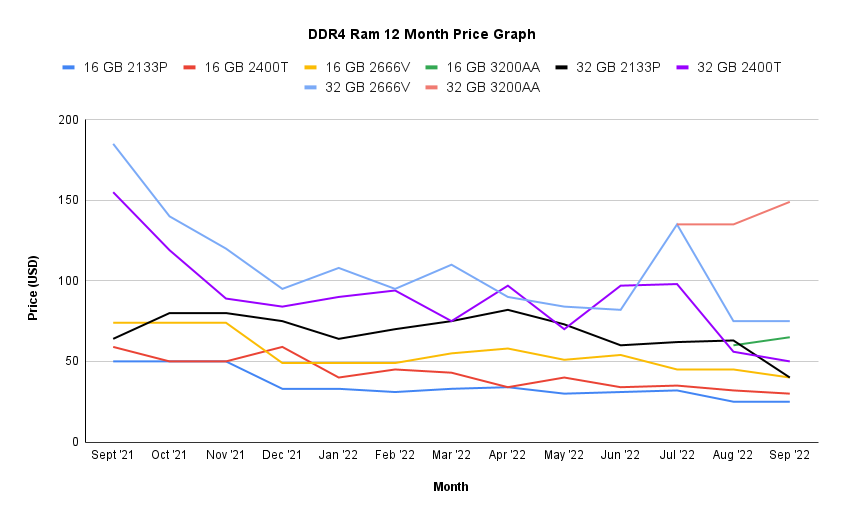
Around this time last year, DDR4 Ram was twice as expensive as it is now. This graph shows the somewhat-steady decline in price as time progressed. The DDR4 memory standard has been around since 2014, and its successor DDR5 was released in 2020. As DDR5 is not backwards compatible, using these bleeding edge DIMMs requires an entire hardware overhaul. As that is not possible at a practical price point, DDR4 remains the frontrunner in high-speed systems at reasonable prices.
We always recommend buying the fastest ram that your CPU can support, and this varies significantly between CPU types. This is mainly why we started tracking the 16GB/32GB 3200AA DIMMS, as they are used for our systems running the new AMD Epyc 7443P Milan CPU. For Epyc CPUs in particular, the speed of the Infinity Fabric communication link between CPU cores is tied to the memory speed. Because of this, for Epyc in particular, you see a big improvement in performance when you use the fastest ram speed the server supports. For Intel CPUs, the difference is less dramatic and in some cases slower ram doesn’t impact performance at all. All in all, matching the RAM speed to the CPU can save you some money here, by only buying RAM speeds your CPU supports, instead of faster more expensive ram that provides no benefit.
_______________________________________________
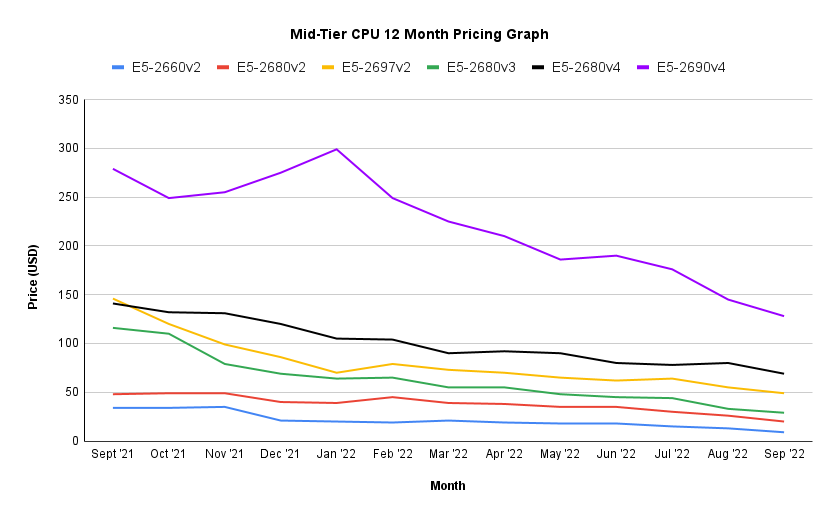
As it seems to be the trend for most aftermarket hardware, CPU prices have dropped gradually over the last year. At this time, the majority of the E5 Family can be found under $100 on the aftermarket. We currently use the 14-core E5-2680v4 as the standard CPU for more performance-centric systems as you are now able to configure a dual E5v4 processor system that provides excellent performance at a bargain price. In general, if you are currently running a server with lower end CPUs, like the Intel E3 Family, or the E5-2620 or E5-2620v2 CPUs, now would be a good time to think about upgrading. Especially in the case of systems running E5-2620 or E5-2620v2, you may be able to upgrade to a E5-2680v2 while using the same motherboard. However you will need to check for compatibility, as some motherboards may require BIOS updates, or may only be compatible with E5v1 CPUs.
_______________________________________________

The high end CPU chart can be thought of as a “placeholder”, where we track CPUs we expect to drop in price in the future. At this time, the prices have not fluctuated much to make them attractive for common use. In fact, the prices for both Platinum types are at the same range that they were at the time of our last quarterly posting. However, while these CPUs are not currently compelling, they represent some of the best performance possible on their respective platform, and can be used for price vs performance comparisons when choosing a lower-tier CPU.
_______________________________________________
We will be posting more quarterly reports throughout the course of the year. We believe these graphs will help identify trends in pricing.
For independent hosting companies, the price of hardware will always be an important factor. Knowing the “average” price for a piece of hardware will help keep operating costs down as well as get rid of the guess work when looking for materials.
For customers of dedicated hosting companies, this information can be valuable when negotiating with hosting providers. For example, when you know that E5-2680v2 CPUs cost less than $50 each, it makes you wonder why some hosts are still offering E5-2620v2 servers instead of updating them to much higher performance compatible CPUs like the 2680v2.
As always, IOFLOOD loves servers, and if you do too, we hope you’ll join us! If you’re interested in hosting with a company that loves servers and treats customers fairly, contact us. We can be reached at sales[at]ioflood.com, or you can check out our dedicated servers page for more info.


